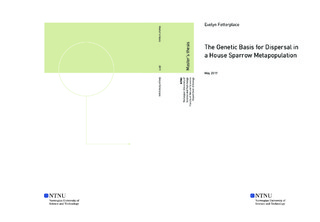| dc.description.abstract | Dispersal is an ecologically important trait that shows phenotypic variation in many populations, and which may play an increasingly important role in population dynamics as the climate changes. Dispersal and traits associated with dispersal, have been shown to be highly heritable in many species, including some bird species. For these reasons, dispersal is a suitable and interesting trait for investigating genetic architecture.
Knowledge of the underlying genetic architecture is required to understand the mechanisms driving phenotypic change in dispersal and to interpret their involvement in eco-evolutionary cycles. Previous studies have revealed several genes which may influence dispersal, but studies on dispersal as a phenotypic trait in itself, rather than traits associated with dispersal, are few, and the number of causal loci and their locations in the genome is largely unknown.
In this study, phenotypic, pedigree and genome wide SNP data, from an insular house sparrow metapopulation off the coast of northern Norway, was used to explore the genetic basis of dispersal. Rather than investigating specific traits that may be associated with dispersal in the house sparrow, the dispersal phenotype was defined as an individual that left their natal island, and successfully established on a new island. Heritability for dispersal was estimated using animal models in MCMCglmm, and dispersal was found to be a highly heritable trait. Genome partitioning analyses did not find a significant, positive relationship between chromosome size and proportion of variance explained. In addition, chromosome 12 explained a disproportionate amount of the variance in dispersal. GWA analysis was used to search for causal loci and revealed one locus of significant effect. No genes that have been associated with dispersal were found near significant or suggestive loci.
This work illustrates both the difficulties and advantages of performing association studies in natural populations and investigates the genetic architecture of dispersal in house sparrows. | |
